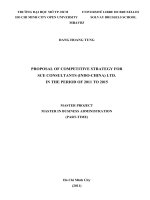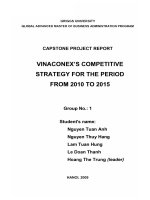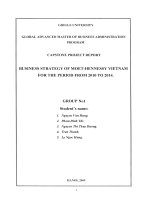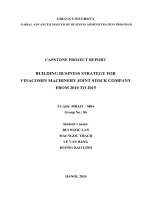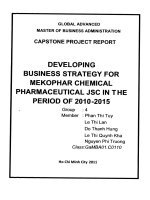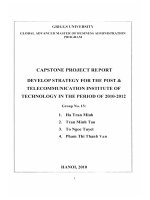Strategy electrical equipment market penetration Vinasino electrical equipment joint stock company (VSEE) in the period from 2010 to 2015
Bạn đang xem bản rút gọn của tài liệu. Xem và tải ngay bản đầy đủ của tài liệu tại đây (1.26 MB, 95 trang )
Group No.2
Student’s name:
1. HA THANH PHONG
2. HOANG MINH DUNG
3. LUU NGOC MAI PHI
4. HO THI ĐINH
5. LE THI HONG
CLASS: GeMBA01.E02
Ho Chi Minh City, December 2009
Class GeMBA01.E02 Capstone project report Group No:2
Page 2
CONFIRMATION
Ho Chi Minh city, Dated December 22nd, 2009
To whom it may concern
Subject: Comments of the VINASINO ELECTRICAL EQUIPMENT JOINT
STOCK COMPANY (VSEE) on the capstone project report of the Group 2,
GeMBA01. E02 Class – MBA in Finance, Griggs University.
1. The students have closely followed up the current situation of business activities of
VSEE to implement the project;
2. The content of "STRATEGY ELECTRICAL EQUIPMENT MARKET
PENETRATION VINASINO ELECTRICAL EQUIPMENT JOINT STOCK
COMPANY in the period from 2010 to 2015" project mentions the goals that VSEE
is trying to reach, and has high feasibility;
3. The display and content of the project is scientific.
Deputy General Director
Tô Công Thanh Lộc
VINASINO ELECTRICAL EQUIPMENT JOINT STOCK COMPANY
Address: R4-52 Hung Gia 2, Bui Bang Đoan Street, Phu My Hung, HCM City
Telephone: +84 8 5410 3686; Fax: +84 8 5410 3685
Email: Website:
TABLE OF CONTENTS:
STRATEGY ELECTRICAL EQUIPMENT MARKET PENETRATION
VINASINO ELECTRICAL EQUIPMENT JOIN STOCK COMPANY
(VSEE)
Page
INTRODUCTION 1
1. The necessity of topics 1
2. Objective research 2
3. Scope of research 2
4. Research method 3
5. Layout of capstone project report 3
CHAPTER 1 - THEORY BASIS OF THE ENTERPRISE'S STRATEGY
1. The basic concept of strategy 5
2. Classification 5
2.1. Corporate strategy 5
2.2. Strategic Business Unit (SBU) 6
2.3. Functional strategy 6
3. Specific strategies 6
4. Base construction of business strategy for enterprises 7
4.1. External environment analysis 7
4.1.1. General environment 7
4.1.2. Sector environment 8
4.2. Internal environmental analysis of enterprise 12
4.2.1. Personnel 12
4.2.2. Finance 12
4.2.3. Marketing 12
4.2.4. Administration activity 13
4.2.5. Information System 13
5. Tools for strategic planning and selection 13
5.1. Tools for strategic planning 13
5.1.1. Internal factor evaluation matrix (IFE) 14
5.1.2. External factor evaluation matrix (EFE) 14
5.1.3. Competitive image matrix 16
5.1.4. Strength- weaknesses - opportunities – threats Matrix (SWOT) 16
5.2. Tool for strategic selection 17
CHAPTER 2 - THE REALITY ANALYSIS
1. Company Profile (VSEE) 18
2. General Environment 18
2.1. Investment Environment: 18
2.1.1. General of investment nation 18
2.1.2. Legal environment in Vietnam 19
2.1.3. Preferential tax policies in the industrial Zones 20
2.2. Sector environment 20
2. 2.1. Economic characteristics of the industry highlights 20
2.2.2. Five forces of competitive position 21
2. 2.3. Product stream projection 26
2.2.4. Competitors of each product stream 28
2.2.4.1. Electronic meters 28
2.2.4.2. Dry medium-voltage Current transformer (CT)
and Voltage transformer (VT) 30
2.2.4.3. Polymeric insulator 32
2.2.4.4. The other kinds of products 33
2.2.4. Price 35
2.2.5. EFE matrix 37
3. Internal environment of VSEE 38
3.1. Reasons for establishing VSEE 38
3.2. Human, organization 38
3.3. Finance 40
3.4. Marketing 40
3.5. Management 42
3.6. VSEE’s partners 42
3.6.1. Introduction about corporations’ domestic capital 42
3.6.2. Foreign partner’s capital (ZPEIC) 43
4. SWOT matrix 44
5. Internal Factor Evaluation Matrix (IFE) 46
6. Specified Strategies 47
6.1- Market penetration strategy 49
6.2- Differentiated strategy 49
6.3- Backward vertical integration strategy 50
6.4- Horizontal strategy 51
7. Analysis of orientations 52
7.1. Orientation development of electrical equipment industry of the State 52
7.2. Electrical equipment market penetration orientation of VSEE 53
8. Threats 53
9. Estimation reasons of mentioned problems 55
CHAPTER 3 - SOLUTIONS
1. Planning development stages of VSEE 57
2. Human resource development solution 58
3. Marketing solution 59
3.1. Product solution 59
3. 1.1. Electronic meters 59
3. 1.2. Current Transformer (CT) and
dry medium-tension voltage transformer (VT) 61
3.1.3. Polymer insulation 62
3.2. Price solution 63
3.3. Distribution solution 63
3.4. Promotion solution 64
4. Business plan 65
4.1. Electronic Meter 65
4.2. Current transformer (CT), voltage transformer (VT) 69
4.3. Polymer insulation 72
5. Financial solution 75
RECOMMENDATION 77
CONCLUSION 79
LIST OF ABBREVIATIONS :
- CT: Current transformer
- DNPC: Dong Nai Power Company .
- EFE: External Factor Evaluation Matrix
- EMC: Thu Duc Electro Mechanical joint stock company
- EMIC: Electric measurement instrument Corp.
- EVN: Vietnam Electricity Group.
- HCMPC: Ho Chi Minh City Power Company
- IFE: Internal Factor Evaluation matrix
- KHPC: Khanh Hoa Power Joint Stock Company
- PC: Power Company
- THIBIDI: Electrical equipment Corp.
- QSPM: Quantitative Strategic Planning Matrix
- VSEE: VINASINO Electrical equipment Corp.
- VT: Voltage transformer
- ZPEIC: Zhejiang Provincial Electric Investment Power Company .
LIST OF TABLES :
- Table 2.1: Tax Incentive for Industrial Zones
- Table 2.2: Purchase situation of electrical materials – equipment in joint stock companies
- Table 2.3: The quantity, types of electric meter are used in 20 branches of PC2 that need
replaced.
- Table 2.4: Current transformer need up to the year 2015 of the PCs
- Table 2.5: Needs of Polymer’s electrical insulation until 2015 of PCs
- Table 2.6: The price of VSEE’s electrometers - electrons in comparison with other
companies’ in Vietnam market
- Table 2.7: The price of VSEE’s current transformers in comparison with other
companies’ in Vietnam market.
- Table 2.8: The price of VSEE’s porcelain insulations in comparison with other
companies’ in Vietnam market.
- Table 2.9: EFE MATRIX
- Table 2.10: Rate and the amount of sum contributed (USD)
- Table 2.11: Internal factors evaluation matrix (IFE)
- Table 2.12: QSPM of VSEE (Group S-O )
- Table 3.1: The planned revenue of the electronic meters products in the first period .
- Table 3.2: Sensitivity of NPV as changing the capacity and interest rates
- Table 3.3: The revenue and the plans of products CT-VT
- Table 3.4: Sensitivity of NPV as changing the capacity and the interest rates
- Table 3.5: The revenue and the plans of polymer insulator products (USD)
- Table 3.6: Sensitivity of NPV as changing the capacity and the interest rates
- Table 3.7 : Period of Contributed capital
LIST OF FIGURES :
- Figure 1.1: Michael E Porter's five forces of competitive position model
- Figure 1.2: The main contents of analysis competitors
- Figure 2.1: Purchase situation of electrical materials equipment in joint stock companies
- Figure 2.2: Organization chart of VSEE
- Figure 3.1: Type of meter is using in PC2
Class GeMBA01.E02 Capstone project report Group No:2
Page 1
INTRODUCTION
Vietnam is currently in the stage of integration into the regional economy and the world.
This has made Vietnamese enterprises more favorable development. In the fluctuating
business environment, besides development opportunities, it also creates pressures for
the Vietnamese enterprises that want to survive and develop must have business
strategies consistently with the actual situation.
Enterprises’ competitive capacity is the competitive foundation of the economy. In
recent years, Vietnam's accession to the WTO, along with the current tax cuts, a variety
of goods from the importing countries makes sure that there is a competitive increase in
Vietnam market. Moreover, after the global economic crisis, peaked in 2008, the
countries’ economy has begun recovering at the present. Countries have focused on the
development of the enterprises’ products, creating conditions for their goods to penetrate
into other countries’ market. Vietnam is one of the very suitable markets for the
penetration of this source of goods
Facing with great challenges, Vietnamese enterprises must address to the problem: Be
competitive in the domestic market and penetrate into the world market step by step. The
only solution to this problem is that manufacturing enterprises in Vietnam must have a
strategy to enhance their enterprises’ competitiveness
Business strategy has to determine the method of organization to complement and make
competitiveness higher and stronger. Practice methods improving factors of enterprises’
competitiveness. These factors include ability to design new products, applying new
production technology, quality control process, marketing, production capabilities and
human resources. Based on the theory, there is a close relationship between these
competitive factors and enterprises’ performance
1. The necessity of topic
Electronic industry in Vietnam, especially the precise electronic industry is still very
weak. Enterprises producing electricity and electronics just stop at the assembly,
Class GeMBA01.E02 Capstone project report Group No:2
Page 2
processing, components which are mainly imported from abroad - the main products are
civil products- and there are a few kinds of electrical equipment used for the industry.
Therefore, Vietnamese electronic enterprises’ competitiveness is still quite weak.
VSEE is a manufacturing enterprise and trading electrical equipment products. This is a
joint stock corporation, with capital contributions from the four power companies
belonging to EVN (PC2, HCMPC, KHP, DNPC) and Zhejiang Electric Power (China).
Currently, the corporation is in the process of implementing lines production in Vietnam.
This is a corporation specializing in producing specific products and providing for
electricity sectors and these are strategic products in the development direction to have
the target of digital services in providing for customers’ electricity use. At the present,
these products have to be mainly imported from abroad with high cost; so VSEE will
bear great pressure due to the competition of these foreign products. It is necessary for
the corporation to map out directions to promote the advantages of availability, market
penetration, and good preparation for their competitive capability in next time. Since
then, we would like to choose “Electrical equipment market penetration at the VSEE
Corporation” is our great topic.
2. Objective research
With this topic, we wish to achieve the following objectives:
- Building business strategies for VSEE. Based on the basis of environmental analysis to
identify VSEE’s current strengths and weaknesses as well as threats, and opportunities
affecting the development of the corporation.
- Proposing solutions to implement the issued strategies
3. Scope of research
Focusing on strategic planning for VSEE’s Vietnam electric equipment market
penetration. In the framework of the group’s research, we limit in the early stages of
strategic management. Strategy is built for strategic business units and solutions to
support the implementation of the strategy.
Class GeMBA01.E02 Capstone project report Group No:2
Page 3
4. Research method
Research is based on quantitative and qualitative research.
- Qualitative research:
Defining the criteria that customers often put out the options and decisions to buy
products of the corporation.
Determining the level of customers’ satisfaction and desiring for each criterion
listed above.
- Quantitative research:
Based on the results of above qualitative analysis, designing questionnaires and
conducting quantitative analysis. Data is processed by the SPSS program and
manipulated in the SWOT analysis.
In the process of implementation, the methods are used as follows:
Method of gathering information:
Secondary information from:
- Internal resources of the corporation: records, statistics, archives, reports, business
plans,
- External resources: Newspapers, radio, the statistics, internet
Primary information from:
- Getting opinions from the Board of Directors and experts of the corporation
- Getting opinions from customers through interviews, consultation
Method of information process:
Manipulating techniques, the strategic management tools make:
- Analyzing the business environment to identify VSEE’s opportunities, risks, strengths,
weaknesses.
- Manipulating SWOT analysis to combine the opportunities, risks, strengths,
weaknesses to set out strategies for VSEE.
5. Layout of capstone project report
Apart from the opening words, recommendations and conclusions. Capstone
project report is divided into 03 chapters:
Class GeMBA01.E02 Capstone project report Group No:2
Page 4
Introduction
Chapter 1: Theoretical basis about competitive strategy of enterprises
Chapter 2: The realities analysis
Chapter 3: Solutions and recommendations
Conclusion
References
Appendix
Class GeMBA01.E02 Capstone project report Group No:2
Page 5
CHAPTER 1:
THEORETICAL BASIS ABOUT COMPETITIVE
STRATEGY OF ENTERPRISES
1. The basic concepts of strategy
The term “strategy” has been used in the military since the 1960s, the strategy has been
applied in business and the term “business strategy” was born. However, the strategic
business administrators understand it in many different ways. This means they approach
it in many different ways.
According to Alfred Chandler: Strategy is the determination of the fundamental goals,
long-term business, or choose the direction and allocation of resources needed to
implement that goal.
According to Fred R. David (2003): Strategy is the means of the long-term goals.
According to Rudolf Grunig and Richard Kuhn (2003): Strategy is a long-term, oriented
management to ensure to finish the long-term goals and corporation’s essential purposes.
In brief, whatever methods they approach, business strategy also encompasses as
follows:
- Identifying the fundamental goals, long-term organization
- Issuing general action program.
- Choosing action plans, implementing and allocating resources to carry out goals.
2. Classification
2.1. Strategy for companies: As models of the corporation’s decisions, it is clearly
defined and outlined goals, the objectives of the corporation, identifying the business
activities that the corporation is pursuing, creating policies and fundamental plans to
achieve the objectives of the corporation. In an organization with scale and extent of
diversity, corporation’s strategy typically applies to all enterprises.
Class GeMBA01.E02 Capstone project report Group No:2
Page 6
Corporation’s strategy is set out to determine the business activities in which corporation
will compete and distribute resources among the business activities.
2.2. Strategic Business Unit (SBU): Business strategy is planned to determine the
selection of products or markets for private business activities in the internal corporation.
This strategy determining the way of each business unit will attempt to complete its goal
and contribute to accomplishing the business units’ goals.
2.3. Functional strategy: This strategy is focused on supporting the strategic
layout of the corporation and is concentrated on the areas of industrial cooperation and
the business sectors.
3. Specific strategies:
According to Fred R. David (2003): Business strategies are divided into four categories
as follows:
- Vertical strategies:
+ Forward vertical integration: enhancing the ownership or control on distributors
and retailers.
+ Vertical integration: looking for the ownership or control on suppliers.
+ Horizontal strategies: looking for the ownership or control on competitors.
+ Penetration market strategy: seeking to other markets for current products and
services of resisting markets through more marketing attempts
+ Market development strategy: bringing current products and services to new
segments
+ Product development strategy: improving sales through innovation or
modification of current products or services
- Operational expansion strategy:
+ Concentric diversification: adding more new products or services which have
relation.
+ Conglomerate diversification: adding more new products or services without
relation.
+ Horizontal diversification: adding new products or services that appeal to current
customers.
Class GeMBA01.E02 Capstone project report Group No:2
Page 7
- Other strategic groups:
+ Alliance strategy: two or more companies create an independent company for
the corporative purposes.
+ Narrow strategic activities: Restriction strategy: reconsolidating through cost
and equity cutting to reserve decreased revenue and profits.
+ Removal of less strategic activities: Cutting operation strategy: selling one
subsidiary or part of the company
+ Liquidation strategy: selling all of tangible and intangible assets
+ Combined strategy: pursuing two or more strategies at the same time.
4. Construction base of business strategy for enterprises
4.1. External environment analysis
External environment is a system of complex factors that there are always opportunities
and risks affecting the business activities in different levels.
Although the scale of potential resources is very large, enterprises does not react with all
changes of the market. So, when analyze the external factors , administrator want to
identify list of investment opportunities in the environment that can give beneficial
business and threats, from here, business needs measures to prevent or avoid.
External environment includes: the general environment and sector environment.
4.1.1. General environment
Elements of the general environment: Economic environment; political and legal
environment; natural environment; social and population environment; and technological
environment.
Economic environment: The impact of this environment has more direct and dynamic
natures than some other factors of the general environment. The evolutions of the
macroeconomic environment always contain the different opportunities and threats for
each enterprise in different sectors and have potential influence on enterprises’ strategy.
Some basic factors are most interested: the trend of gross domestic product (GDP) and
Class GeMBA01.E02 Capstone project report Group No:2
Page 8
gross national product (GNP) and interest and interest trends; balance of international
payments, levels of inflation; tax system and tax
Political and legal environment: Including the system of opinions, policies of the Party
and State, the current legal system. Besides, also needing to master the trend of political
diplomacy of the government and the domestic and foreign political evolutions. These
factors affect enterprises’ formation and development.
Natural environment: Enterprises have recognized the impact of natural circumstances
on their business decisions for a long time. The natural effects include: geographical
location, climate, pollution, and lack of energy and wastage of natural resources together
with the increase in the demand of resources provided by nature, society, and level of
awareness and general education of society. These factors affect enterprises’ business.
Therefore, enterprises should pay attention to these factors when planning business
strategy.
Technological environment: The impacts of technology create opportunities and risks
as well in the process of strategic management for enterprises. Technological advances
may create new markets, as a result, creating new products and making available
products and services become out of date. This environment strongly affects
manufacturers relating to fields such as telecommunications, computing and information.
Therefore, enterprises in electronic products also need to mind these factors in the
process of negotiating with good suppliers in order to create opportunities for
themselves.
4.1.2. Sector environment
Applying Michael E Porter's five forces of competitive position model (1985) to analyze
enterprises’ sector environment (also called structural analysis in a competitive industry).
The relationship among these factors is reflected in Figure 1.1.
Class GeMBA01.E02 Capstone project report Group No:2
Page 9
Figure 1.1: Michael E Porter's five forces of competitive position model
Source: Michael E Porter (1985)
(1) Competitors: The key contents of a competitive analysis are presented in Figure1.2.
Class GeMBA01.E02 Capstone project report Group No:2
Page 10
Potentiality
Both strengths
and weaknesses
Purposes
future
At all levels of
management
and multi-
dimension
Some problems for
competitors:
- Do competitors content
with the present situation?
- What ability do
competitors shift capital
and strategic direction?
- What are competitors’
weaknesses?
- What could help
competitors to work
effectively?
Current business
strategy
How is enterprise
competing?
Consideration
Its influence
and industry.
What competitors
want to reach?
What competitors
are doing and can
do?
Figure 1.2: The main contents of analysis competitors
(2) Customers : Customers decide enterprise’s fate. Customers’ prestige may be
enterprise’s best assets. The prestige is achieved by knowing how to satisfy customers’
Class GeMBA01.E02 Capstone project report Group No:2
Page 11
needs and tastes better compared to competitors. Pressure from customers comes from
the following conditions:
- The amount of goods buyers occupy larger than the volume of goods sold by the seller.
- The purchase of switching to another without causing more costly.
- Buyers give the signal of credible threats that they will integrate on the back (reverse)
to suppliers.
- Goods that customers buy belong to a specialized low level.
(3) Suppliers: Suppliers may assert their power by threatening to increase or reduce the
quality of products and supplying services. Suppliers will have advantages if they meet
the following conditions:
- Only a small number of suppliers sell to a large number of buyers in the same sector.
- Goods substitutes are not available
- Suppliers’ goods or services are under the essential type and the highly specialized
level.
- Suppliers issue threatening signals reliably that they are going to integrate in forward
direction.
(4) Potential competitors: New competitors in the industry can be a factor reducing
profits because they have exploited new production capacities with the desire to gain
necessary market shares and resources.Therefore, the protection of enterprises’
competitive position includes the maintenance of legal barriers prevents penetration from
outside. The main barriers are the advantage of large-scale production, product diversity,
requirement of big finance resources, costs of high-qualified item conversion, the limited
abilities in the penetration of the strong consuming channel and price advantage that
competitors do not create.
(5) Product substitutes : These product substitutes reduces the potential profitability of
the industry by imposing a ceiling with prices that the competition of prices compared to
competed products; these industries have high profits, the product substitutes in the
current market will increase competition in the industry and create a decrease of prices or
Class GeMBA01.E02 Capstone project report Group No:2
Page 12
improve quality.
The stronger competitive forces are, the more limited the abilities are in order that
companies increase prices and get higher profits; or can be considered as a threat to
reduce low-profit
The power of five forces can change over time when industry conditions change. We
need to recognize opportunities and risks because the changes of five forces will bring to
build suitable strategies.
4.2. The internal environmental analysis of enterprise
Enterprise’s internal environmental analysis is the basis to help the enterprise know the
strengths, weaknesses compared to its competitors; simultaneously it helps
administrators know the ability to capture a competitive advantage in each period.
Factors of internal functions include: Personnel, finance, marketing, management
activity, and information system.
4.2.1. Personnel: In the fluctuating business environment, enterprise’s human resources
play an important role in the process of implementing strategies and decides the success
or failure of the enterprise. If the strategy is right, promising and feasible but people in
the organization do not have enough capacity to carry out, strategy will not be effective.
The main function of human resources is as recruiting, training, use, treatment,
evaluation, encouragement and firing.
4.2.2. Finance: Financial condition is generally considered an assessment method in the
best competitive position of the corporation and is the most attractive condition for
investors. In order to formulate effective strategies, it is necessary to identify the
strengths and weaknesses of financial business. It is shown through the analysis of some
basic financial indicators such as liquidity, asset structure, capital structure, profitability
rate This will make the construction of the corporation’ strategy to be feasible.
4.2.3. Marketing: Marketing research to identify market opportunities, market
segmentation, target market selection and market position; simultaneously analyze
Class GeMBA01.E02 Capstone project report Group No:2
Page 13
business designing, implementing organization and examine product, price, distribution
network strategies and sales promotion.
Understanding the marketing activities, administrators will determine the specific tasks
of these functions and the tasks can be performed in each period.
4.2.4. Administration activity : Management includes four basic functions such as
planning, organization, leadership and control.
- Planning: including all administrative activities related to preparing for the future.
Particularly, they are forecasts, goal establishments, strategy settings, policy
developments and plan formations.
- Organization: including all administrative activities to create the structure of the
relationship between rights and responsibilities. Specifically they are organizational
designing, work specialization, job descriptions, work details, control expansions, order
unifications, arrangement coordination, and job design and work analysis.
- Leadership: including efforts to orient human activities, particularly they are
leaderships, communications, joint working groups, activity changes, authorizations, the
improvement of the work quality ,work satisfactions , need satisfactions , organizational
changes, the spirit of the staff, and mental management.
- Control: In relation to all management activities to ensure the results match reality,
consistent with the results was planned. The main activities: quality control, financial
control, sales, inventory, expenses, analyze changes, payoff.
4.2.5. Information System: Information links all business functions together and
provide the basis for all management decisions. It is the foundation of all organizations.
Information expresses disadvantages or principal competitive advantages.
Information system is an important strategic resource, monitoring the changes of the
environment, recognizing the threat of competition, and supporting for implementation,
evaluation and strategy control.
5. Tools for strategic planning and selection :
5.1.Tools for strategic planning
Class GeMBA01.E02 Capstone project report Group No:2
Page 14
Derived from the real situation in business preparation in VSEE, appropriate tools to plan
strategy for the corporation as follows:
5.1.1. Internal Factor Evaluation matrix (IFE)
Internal Factor Evaluation matrix (IFE) is a tool that is used to summarize and evaluate
the strengths and weaknesses of key sales functions, and it also provides the basis to
determine and evaluate the relationship among functions.
According to Fred R. David, IFE Matrix can be developed in five steps:
- Step 1: Listing factors that have been identified in the process of internal analyze.
Use from 10 to 20 internal elements, including the strengths and weaknesses.
- Step 2: Assigning significance by classifications from 0.0 (not important) to 1.0
(most important) for each factor. The importance assigned to each factor for certain
relative importance of factors for the success of companies in the industry. Total of all
levels of this important right by 1.0.
- Step 3: Classifying from 1 to 4 for each factor, representing for the biggest
weakness (classified by 1), the smallest weakness (classified by 2), the smallest strengths
(classified by 3), or the biggest strengths (classified by 4). Such classification is
important to score each variable.
- Step 4: Multiplying the importance of each variable with its type to determine the
number of important point (step 2 x steps 3).
- Step 5: Adding all the important points for each variable to determine the total
number of important points of the organization.
Regardless of IFE matrix has how many factors, the total number of important points can
be classified from the lowest of 1.0 to the highest of 4.0 and the average score is 2.5.
The total of important number is lower than 2.5 showing that the corporation is
internally weak and the number is higher than 2.5, showing that the corporation is
internally strong.
5.1.2. External Factor Evaluation matrix (EFE)
External Factor Evaluation matrix (EFE) allows summarizing and evaluating on
Class GeMBA01.E02 Capstone project report Group No:2
Page 15
economic information, society, culture, demography, geography, politics, government,
legislation, technology and competition.
According to Fred R. David, the development of an EFE matrix consists of 5 steps:
- Step 1: creating list of factors playing an decisive role for success like being
identified during inspection from the outside elements. Use from 10 to 20 factors,
including the opportunities and threats affecting the corporation and corporation’s
business fields.
- Step 2: Classifying the importance from 0.0 (not important) to 1.0 (very
important) for each factor. The classification shows the factors are relevantly important
to success in the corporation’s business fields. The appropriate level of classification can
be determined by comparing successful competitors with the unsuccessful ones or by
discussing about this factor and obtain the consent of the group. The total number of
classification levels which is pointed for these factors must be equal to 1.0.
- Step 3: Classifying from 1 to 4 for each factor. Such classification is important to
score each variable: 4 is a good response, 3 is responded higher than the average, 2 is
responded on the average and 1 is a little response. Levels based on the effectiveness of
strategies in the corporation. Thus, the classification is based on the corporation.
- Step 4: Multiplying the importance of each variable with its type to determine the
number of important point (step 4 = step 2 x step 3).
- Step 5: Adding the total number of important points of each variable to determine
the number of important points for the organization.
Regardless of the main opportunities and threats are included in the EFE Matrix, the total
number of the highest important points that an organization can have is 4.0 and the
lowest is 1.0.
The total number of important average point is 2.5. The total number of important point
is 4 showing that organizations are responding very well to the present opportunities and
threats in their environment. The total number of important point is 1 showing that
